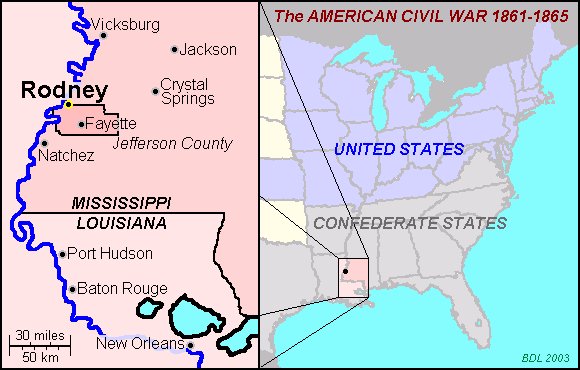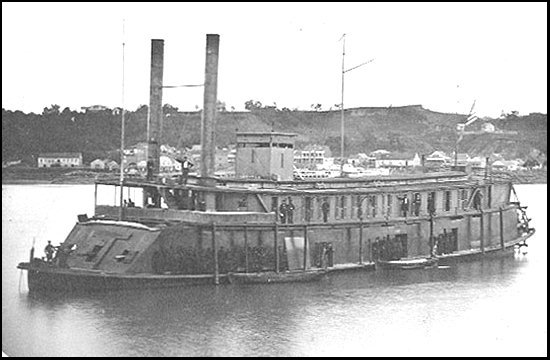
 Jefferson County, Mississippi
Jefferson County, MississippiA Proud Part of the Mississippi GenWeb!
Contact Us:
State Coordinator: Jeff Kemp
County Coordinator: Gerry Westmoreland

If you have information to share, send it to Jefferson County MSGenWeb.
In the menu on the left there is an index of Military Records on our website.
Jefferson County, Mississippi, in the American Civil War
USS
Rattler at Rodney, Sunday, September 13th, 1863
By Bruce D.
Liddell
After six generations few military traces of the
American Civil War 1861-1865 survive in Jefferson County, Miss. One
scar remains today for all to see, a Union cannonball imbedded in
the brick front wall of Old Rodney Presbyterian Church.
The
Civil War passed lightly over Jefferson compared with other parts of
the South. No great battles or orgies of destruction occurred within
the county, but nonetheless “cruel War” left its evil mark. Ravenous
armies stripped the land of livestock and food, taxation and
inflation stripped the people of their money, and slaves themselves
stripped off their bondage at every opportunity. War and
Reconstruction also stripped away the South’s cloak of prosperity
leaving bare poverty, but that’s another issue.
Before the
Civil War Rodney ranked as the largest town in Jefferson, erstwhile
contender for the state capital, at one time reckoned the busiest
river port between New Orleans and St. Louis. After the War the
Mississippi River shifted a few miles west, leaving the town high
and dry. Today Rodney has all but withered away, leading some to
call it a ghost town, though the last remaining resident reportedly
disputes that.

In the summer of 1863 Union forces seized control of the
Mississippi River and cut the Confederacy in two. Vicksburg
surrendered on the Fourth of July (and never again celebrated the
holiday until 1944) and Port Hudson, La., four days later, severing
the Trans-Mississippi states from the Richmond government. For the
next two years Federal warships patrolled the Father of Waters to
shut down all Confederate river traffic. During most of this period
the “tinclad” gunboat USS Rattler enforced Washington’s will at
Rodney and vicinity. (1)
USS Rattler was one of sixty-odd
mixed-bag riverboats purchased and armed by the U.S. Navy, called
“tinclads” to distinguish their bullet-proof qualities from the
heavier cannon-proof ironclads. Drawing on average only 4 feet of
water, the tinclad fleet flaunted the Stars and Stripes with
near-impunity along the Western Rivers. Named for the poisonous
snake, Rattler began her career as the smallish 165-ton stern-wheel
flat-bottom steamboat Florence Miller. (One wonders what humorous
combinations the sailors made from the gunboat’s names.) Designated
Tinclad Gunboat No. 1, she cost the government only $24,000,
one-tenth the price of a purpose-built warship. (2)

USS Rattler at anchor between July 1863 and December 1864. The
vertical mark on the front and side of the pilot house is her
numeric designation, Tinclad No. 1. One authority has identified
the background as Natchez-Under-the-Hill. (3)
USS Rattler
grossly resembles a two-story flat-roof boarding house for thirty or
forty resident crewmen. About 100 feet long and 30 feet wide, her
exact dimensions and internal layout are unknown but can be
surmised. The topmost (texas) deck was removed and replaced with a
rectangular enclosed pilot house. Officers and enlisted men ate and
slept in the former passenger spaces upstairs (hurricane deck) above
the engines on the newly enclosed main (cargo) deck. Hull spaces
remained empty, as riverboats’ flat bottoms sagged under load. Three
guns protruded from an angled casemate at the front (bow) of
Rattler’s cargo deck, one long range Parrott rifle firing 30-pound
shot flanked by two 24-pounder Napoleon smoothbores. Presumably an
identical battery pointed sternward over the paddlewheel. Shielded
all around by heavy timbers, she also carried one or two thicknesses
of half-inch iron plate armor over the forward battery casemate and
around the pilot house. By her mobility and protection virtually
invulnerable from attack by land, Rattler could out-fight every boat
on the river except the heaviest ironclads. (4)
After three
summers of war and slaughter autumn 1863 loomed blessedly peaceful
along the Mississippi River. As the sun rose on a quiet fair-weather
Sunday, September 13th, 1863, USS Rattler lay at anchor near the
Rodney town wharf. Stationed at Rodney since mid-August, she had
returned the previous day from a short visit to squadron
headquarters at Natchez. That Sunday morning Rattler’s captain
Acting Master (modern Lieutenant Junior Grade) Walter Fentress
welcomed a guest on board. Reverend Baker, a Union man, had recently
resigned as pastor of the Red Lick Presbyterian Church and presently
awaited a passenger boat headed “North,” meaning any district under
Federal control. Reverend Robert Price, long-time pastor of Rodney
Presbyterian Church, generously offered his pulpit and collection
plate to Rev. Baker that Sunday. Baker in turn invited Rattler’s
officers and crewmen to attend morning services at the church. (5)
In violation of Admiral David Porter’s standing orders, at 11
a.m. Captain Fentress led most of his crew ashore. None were armed
except Second Assistant Engineer A. M. Smith, who carried a hidden
revolver. All sported their Sunday best; Fentress wore a plain
civilian coat, perhaps to avoid arousing the nominally hostile
citizens. An officer in civilian dress in enemy territory during
wartime runs a terrible risk, and one wonders if Fentress clearly
understood his position. (6)
About 10 minutes after the
worshippers found their pews, Lieutenant Allen of the Confederate
Army walked into the church, interrupted the services with a polite
apology to Rev. Baker, and ordered the U.S. Navy men to surrender. A
noisy fracas ensued. (7)
Perhaps Rattler’s men made a habit
of attending Rodney Presbyterian Church, or possibly a Southerner
named Billy Parsons carried Baker’s invitation to the nearest
Confederate outfit. By one romantic account Lt. Allen donned
civilian dress, silently entered the church and counted the sailors
from the back pew, then slipped outside to change clothes and alert
his men. While music and voices covered any sound Allen directed his
fifteen Confederate scouts to surround the building, then strode
boldly through the church front door. (8)
At the call to
surrender, Engr. Smith drew his pistol and fired one shot through
Lt. Allen’s hat (though this may be an editor’s fanciful phrase for
any near-miss.) At the sound of gunfire inside, the Confederates
outside fired through the windows, all the balls striking the
ceiling or opposite wall. Smith shot three more times, and as fast
as they could reload the cavalrymen pumped more rounds harmlessly
through the shattered windows. Allen discharged his revolver once
into the ceiling, shouting for all to cease fire. (9)
No
doubt confusion and fright reigned among the unwilling participants.
The Jackson Mississippian applauded one strong minded matron who
stood her ground, shouting “Glory to God!” as the Rebels overpowered
the Yankees. One sailor tried to hide under the voluminous skirts of
elderly and immobile “Mrs. I. D. G.,” and other Navy men entertained
similar thoughts. Although several modern writers describe a happy
marriage that resulted from the unwonted intimacy, no confirmation
has been found. The tale may have arisen from the Depression-era
“urban legend” of an ancient Union veteran who went searching for
the long-deceased lady who saved his life in a fight inside a
church. (10)
Lt. Allen finally made himself heard above the
noise. The Rebels stopped shooting and rounded up their Yankee
prisoners. By a seeming miracle, only one seaman received a minor
wound. Allen commandeered civilian carriages for the Union officers
and started the Union sailors marching single file out of town on
the northeast road toward nearby Oakland College, closed and empty
since the outbreak of war. The civilians quickly scattered to their
homes. (11)
Alerted by the gunfire and informed of the cause
by “a negro on shore,” at 11:20 a.m. USS Rattler’s first lieutenant
(modern executive officer or “number one”) Acting Ensign William
Ferguson sent the remnant crew to battle stations, got the gunboat
moving, dropped a boatload of armed sailors to secure the wharf, and
ordered the gunners to open fire. Rattler’s cannons threw fourteen
explosive shells into the town, setting several small fires and
damaging the church and four houses. One shell damaged a barn on
nearby Pecan Grove plantation. Amid the smoke and concussion six
Navy men including combative Engr. Smith escaped to Rattler’s
waiting boat. Ens. Ferguson ceased fire when Lt. Allen’s party and
prisoners were out of sight. By 1:30 p.m. the initial excitement had
passed and Rattler again lay at anchor, but now in deep water. (12)
To his eternal embarrassment Fentress holds a unique
distinction, the only United States Navy ship’s captain captured by
Confederate States Army horse cavalry. (13)
Later that
afternoon Ens. Ferguson decided to burn down a Rebel’s house in
town, after Seaman John Henderson, one of those who escaped,
reported he “was driven from thence by the owner.” Ferguson detailed
an officer, probably Acting Pilot George G. Waggoner, and a boatload
of armed sailors, probably including Henderson, for the job. Rattler
fired eleven more shells to cover their operations. Word of the
incendiarists reached Lt. Allen, who threatened to capture the
outnumbered landing party and hang them as arsonists. (See
discussion of Lt. Allen's threat below.) The sailors meekly returned
to the gunboat, their task left undone. (14)
After dark
Rattler received a petition from ”the principal citizens of Rodney”
begging the U.S. Navy to hold the town blameless, as the townsfolk
had no prior knowledge of the noontime affray. At 10 p.m. that night
a civilian emissary, Dr. Goldsmith, brought a message from Capt.
Fentress requesting clothing for the captives, to be delivered to
Crystal Springs 60 miles away; presumably this was done. Three days
after the ambush Rev. Price and thirty-seven townsmen (unnamed)
signed another petition, Adm. Porter relented, and thus Rodney
avoided the vengeful destruction normally practiced by Union forces.
(15)
Except for one Union cannonball still imbedded in the
brick front wall of the Old Presbyterian Church in Rodney, Miss.
(16)
Epilogue. Some months later Fentress and his men were
exchanged for a like number of Southerners, and resumed their Navy
service at other posts. At the end of 1864 USS Rattler sank near
Grand Gulf, Miss., in a storm, her crew saved but the gunboat a
total loss. In 1930 Gov. Bilbo extinguished the Town of Rodney. In
1966 the United Daughters of the Confederacy took over the Church,
and in 1990 dedicated the building as their Official State Shrine.